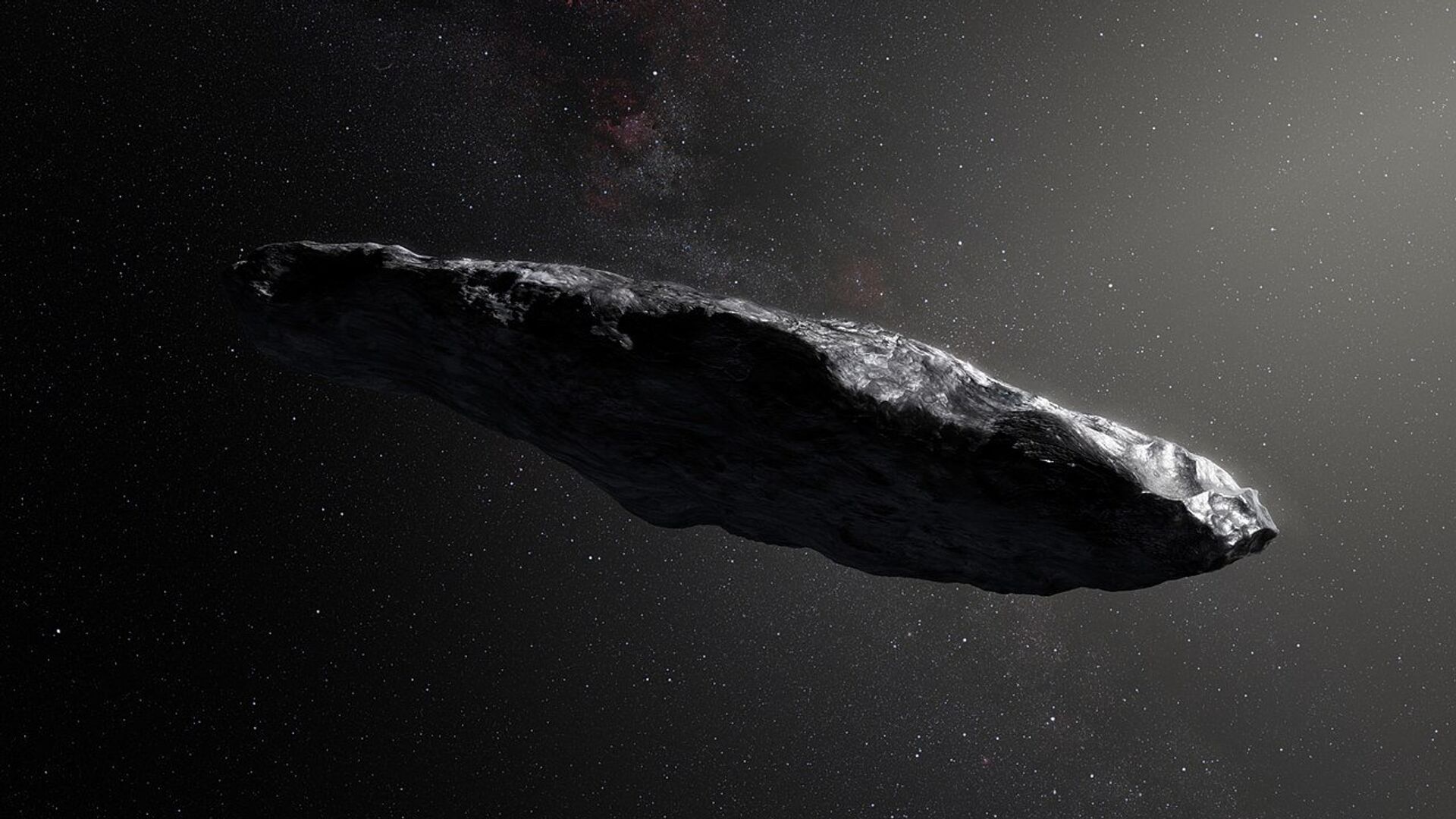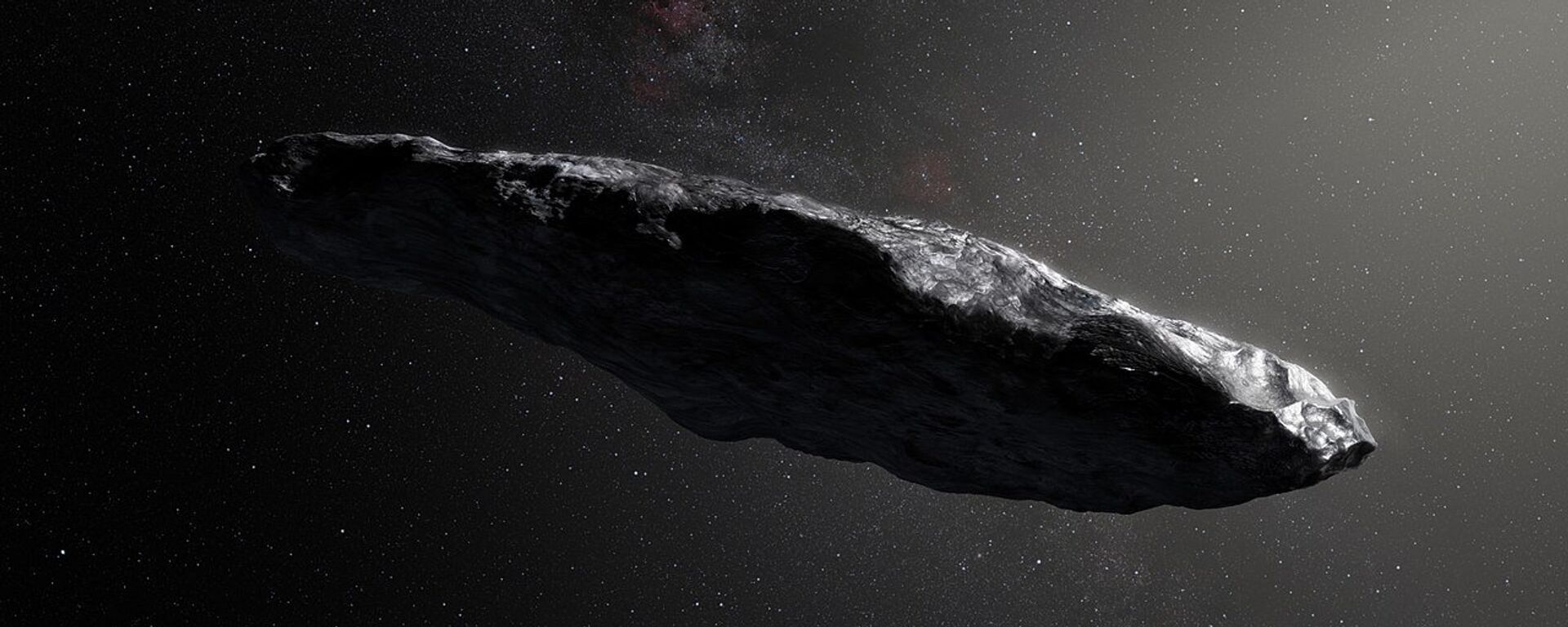https://sputnikglobe.com/20221109/prepping-for-oumuamua-20-scientists-warn-we-need-to-be-ready-for-our-next-interstellar-visitor-1103916494.html
Prepping for ‘Oumuamua 2.0: Scientists Warn We Need to Be Ready for Next Interstellar Visitor
Prepping for ‘Oumuamua 2.0: Scientists Warn We Need to Be Ready for Next Interstellar Visitor
Sputnik International
In 2017, a quarter-mile-long object that may have been ten times as long as it was wide, was identified as the first known and observed interstellar object to... 09.11.2022, Sputnik International
2022-11-09T01:18+0000
2022-11-09T01:18+0000
2023-04-12T16:58+0000
science & tech
interstellar rock
astronomer
study
solar system
warning
space
https://cdn1.img.sputnikglobe.com/img/106585/09/1065850986_0:73:1280:793_1920x0_80_0_0_665e76d05314fc5e88e96e1275736739.jpg
Scientists are warning the public needs to be ready to intercept the next interstellar visitor that passes through our solar system in order to prevent being blindsided as officials were when the still-mysterious ‘Oumuamua made its grand arrival in 2017.‘Oumuamua’s origins and composition remain unknown to scientists, with theories ranging from a shard of an exoplanet to alien technology. Whatever it is, scientists believe that had we been able to observe it closely, we may have discovered more secrets about the formation of our galaxy and what lies beyond our solar system.The biggest mystery about the object may not be its odd size, unknown composition, or where it came from but rather why ‘Oumuamua suddenly sped up while in our solar system - an event that has left scientists stumped.Scientists weren’t ready for ‘Oumuamua as it sling-shotted around the sun and sped out of our reach, first passing Mars and then Jupiter’s orbits. Today, it is estimated to be nearly 3 billion miles away from Earth.Now, scientists are developing a plan for the next interstellar object of interest to pass through our solar system and they want Earth to be ready this time. Harvard astronomer Avi Loeb and astrophysics student Amir Siraj authored a paper detailing what would be required of such a mission.It was Loeb who famously first suggested ‘Oumuamua may have been a piece of alien technology. Their paper includes a potential timeline, the needed speed of the spacecraft, and how close they think the craft should get to the object.Loeb and Siraj suggest that a spacecraft should be laying in wait, ready to intercept any interesting objects that come from outside of our solar system. They suggest it be stored in outer space, possibly in the L2 region, where the James Webb Telescope sits. It could also, they say, be put in orbit of the moon or Earth. It could also be launched from land, but time would be of the essence.After ‘Oumuamua’s discovery in October 2017, the mysterious object reached its closest point to Earth in August 2019 and less than a year later, it was so far out that it can no longer be detected by telescopes.While nearly three years seems like a long time, it is important to remember it takes a long time to go anywhere in space. The paper states that scientists will have weeks between identifying an object and sending a spacecraft after it.Ideally, the craft would get within a few hundred miles of the object and take pictures that would help identify the object’s composition.Siraj and Loeb are not the only ones with plans on tracking down an interstellar object. NASA scientists presented a “Bridge to the Stars” plan in 2020, though that project is still in its conceptual phase. Meanwhile, the European Space Agency has plans to launch a “Comet Interceptor” that will be stored in the L2 region. That project is focused on intercepting objects from the outer edges of our solar system but could be repurposed to catch an interstellar object if one comes nearby.Meanwhile, the Initiative for Interstellar Studies is not ready to give up on ‘Oumuamua yet. Earlier this year they proposed Project Lyra, intending to send a spacecraft after the mysterious object and hope to catch it as early as 2047. If their plan is put into motion, it will require the fastest spacecraft created by man, exceeding the speed of the Voyager probes.That is likely something Siraj would find interesting. “It's remarkable to me that there still isn’t an explanation that doesn't invoke a new type of astrophysical object for ‘Oumuamua,” he said. “That's very motivating for me and, I think, for a lot of scientists.”
https://sputnikglobe.com/20210618/they-could-be-out-there-astronomer-urges-humanity-to-hunt-for-objects-like-oumuamua-1083185557.html
Sputnik International
feedback@sputniknews.com
+74956456601
MIA „Rossiya Segodnya“
2022
News
en_EN
Sputnik International
feedback@sputniknews.com
+74956456601
MIA „Rossiya Segodnya“
Sputnik International
feedback@sputniknews.com
+74956456601
MIA „Rossiya Segodnya“
`oumuamua, interstellar, space
`oumuamua, interstellar, space
Prepping for ‘Oumuamua 2.0: Scientists Warn We Need to Be Ready for Next Interstellar Visitor
01:18 GMT 09.11.2022 (Updated: 16:58 GMT 12.04.2023) In 2017, a quarter-mile-long object that may have been ten times as long as it was wide, was identified as the first known and observed interstellar object to pass through our solar system. Dubbed ‘Oumuamua, the cigar-like object was shaped unlike anything previously observed in our solar system.
Scientists are warning the public needs to be ready to intercept the next interstellar visitor that passes through our solar system in order to prevent being blindsided as officials were when the still-mysterious ‘Oumuamua made its grand arrival in 2017.
‘Oumuamua’s origins and composition remain unknown to scientists, with theories ranging from a shard of an exoplanet to alien technology. Whatever it is, scientists believe that had we been able to observe it closely, we may have discovered more secrets about the formation of our galaxy and what lies beyond our solar system.
The biggest mystery about the object may not be its odd size, unknown composition, or where it came from but rather why ‘Oumuamua suddenly sped up while in our solar system - an event that has left scientists stumped.
Scientists weren’t ready for ‘Oumuamua as it sling-shotted around the sun and sped out of our reach, first passing Mars and then Jupiter’s orbits. Today, it is estimated to be nearly 3 billion miles away from Earth.
Now, scientists are developing a plan for the next interstellar object of interest to pass through our solar system and they want Earth to be ready this time. Harvard astronomer Avi Loeb and astrophysics student Amir Siraj authored a paper detailing what would be required of such a mission.
It was Loeb who famously first suggested ‘Oumuamua may have been a piece of alien technology. Their paper includes a potential timeline, the needed speed of the spacecraft, and how close they think the craft should get to the object.
“This can be a useful resource for any other team that is putting together specific designs for interstellar object missions,”
Siraj told Vice’s Motherboard. “This is basically the physics checklist that the mission needs to satisfy, and this also contextualizes the type of mission that we would need to successfully do this.”
Loeb and Siraj suggest that a spacecraft should be laying in wait, ready to intercept any interesting objects that come from outside of our solar system. They suggest it be stored in outer space, possibly in the L2 region, where the James Webb Telescope sits. It could also, they say, be put in orbit of the moon or Earth. It could also be launched from land, but time would be of the essence.
After ‘Oumuamua’s discovery in October 2017, the mysterious object reached its closest point to Earth in August 2019 and less than a year later, it was so far out that it can no longer be detected by telescopes.
While nearly three years seems like a long time, it is important to remember it takes a long time to go anywhere in space. The paper states that scientists will have weeks between identifying an object and sending a spacecraft after it.
Ideally, the craft would get within a few hundred miles of the object and take pictures that would help identify the object’s composition.
Siraj and Loeb are not the only ones with plans on tracking down an interstellar object. NASA scientists presented a “Bridge to the Stars” plan in 2020, though that project is still in its conceptual phase. Meanwhile, the European Space Agency has plans to launch a “Comet Interceptor” that will be stored in the L2 region. That project is focused on intercepting objects from the outer edges of our solar system but could be repurposed to catch an interstellar object if one comes nearby.
Meanwhile, the Initiative for Interstellar Studies is not ready to give up on ‘Oumuamua yet. Earlier this year they proposed Project Lyra, intending to send a spacecraft after the mysterious object and hope to catch it as early as 2047. If their plan is put into motion, it will require the fastest spacecraft created by man, exceeding the speed of the Voyager probes.
That is likely something Siraj would find interesting. “It's remarkable to me that there still isn’t an explanation that doesn't invoke a new type of astrophysical object for ‘Oumuamua,” he said. “That's very motivating for me and, I think, for a lot of scientists.”


